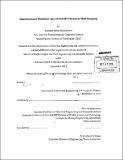| dc.contributor.advisor | Elfar Adalsteinsson. | en_US |
| dc.contributor.author | Abuhashem, Obaidah Anees | en_US |
| dc.contributor.other | Massachusetts Institute of Technology. Department of Electrical Engineering and Computer Science. | en_US |
| dc.date.accessioned | 2014-03-06T15:39:24Z | |
| dc.date.available | 2014-03-06T15:39:24Z | |
| dc.date.copyright | 2013 | en_US |
| dc.date.issued | 2013 | en_US |
| dc.identifier.uri | http://hdl.handle.net/1721.1/85401 | |
| dc.description | Thesis: M. Eng., Massachusetts Institute of Technology, Department of Electrical Engineering and Computer Science, 2013. | en_US |
| dc.description | Title as it appears in MIT degrees awarded program, September 18, 2013: Simultaneous multislice spiral chemical shift imaging. Cataloged from PDF version of thesis. | en_US |
| dc.description | Includes bibliographical references (pages 99-102). | en_US |
| dc.description.abstract | The current prominent excitation methods of 3D slabs used for MR Spectroscopy Imaging (MRSI) include long dead times in each TR. This dead time is necessary for magnetization moments' longitudinal relaxation, and so a good SNR efficiency. The fact that SNR is one of the dominant challenges that MRSI faces makes it an expensive tradeoff to decrease the dead time in the 3D excitation methods. Therefore, I investigate the possibility of using 2D slice excitation methods with simultaneous multi-slice excitation and the associated reconstructions to address some of the limitations of 3D excitations with the goal of increasing the overall efficiency of the MRSI acquisition and acquiring one average in a much faster time. The benefit of using simultaneous multislice for 2D spectroscopy is explained, and it is shown how this method can accelerate the 2D acquisition with quantifications of the involved tradeoffs. Then the details of designing RF pulses for SMS spectroscopy imaging are explained, and a pulse to be used is proposed. I discuss the sequences used to encode the k-space, where spiral trajectories are an efficient choice. Therefore, a method that can be used for SMS spiral spectroscopy acquired data is proposed. The proposed method accelerates the minimum scan time of 2D excitation for a single average by a factor of four. This acceleration is possible with SNR degradation less than 7% of the ordinary 2D excitation method. | en_US |
| dc.description.statementofresponsibility | by Obaidah Anees Abuhashem. | en_US |
| dc.format.extent | xvi, 102 pages | en_US |
| dc.language.iso | eng | en_US |
| dc.publisher | Massachusetts Institute of Technology | en_US |
| dc.rights | M.I.T. theses are protected by copyright. They may be viewed from this source for any purpose, but reproduction or distribution in any format is prohibited without written permission. See provided URL for inquiries about permission. | en_US |
| dc.rights.uri | http://dspace.mit.edu/handle/1721.1/7582 | en_US |
| dc.subject | Electrical Engineering and Computer Science. | en_US |
| dc.title | Simultaneous multislice spiral and EPI chemical shift imaging | en_US |
| dc.title.alternative | Simultaneous multislice spiral chemical shift imaging | en_US |
| dc.type | Thesis | en_US |
| dc.description.degree | M. Eng. | en_US |
| dc.contributor.department | Massachusetts Institute of Technology. Department of Electrical Engineering and Computer Science | |
| dc.identifier.oclc | 870305236 | en_US |
